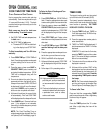
14
NOTE: Only use a CLEAN, DAMP
“scratchless” pad that is safe for non-stick
cookware. The pattern and glass will be
damaged if the pad is not damp, if the pad
is soiled, or if another type of pad is used.
➢ Burned-on or Crusty Soils – Scrub with
a “scratchless” or “never scratch” scour-
ing pad and Cooktop Cleaning Creme*.
NOTE: Hold a razor blade scraper at a
30° angle and scrape any re-
maining soil. Then, clean as
described above. Do not
use the razor blade
for daily cleaning
as it may wear
the pattern
on the glass.
➢ Melted Sugar or Plastic – Immediately
turn element to LOW and scrape from hot
surface to a cool area. Then turn element
OFF and cool. Clean residue with razor
blade scraper and Cooktop Cleaning
Creme*.
OVEN INTERIORS
➢ Follow instructions on page 12 to set a
self-clean cycle.
OVEN RACKS
➢ Clean with soapy water.
➢ Remove stubborn soil with cleansing pow-
der or soap-filled scouring pad. Rinse and
dry.
➢ If over time, racks do not slide out easily,
wipe the rack edge and rack support with
a small amount of vegetable oil to restore
ease of movement, then wipe off excess
oil. Likewise, place one drop of vegetable
oil on rack roller.
NOTE:
Remove oven racks during a clean
cycle. If racks are left in the oven, it may impair
function and they will discolor.
PLASTIC FINISHES –
T
RIM
&
END
CAPS
➢ When cool, clean with soap and water,
rinse and dry.
➢ Use a glass cleaner and a soft cloth.
NOTE:
Never use oven cleaners, abrasive
or caustic liquid or powdered cleansers on
plastic finishes. These cleaning agents will
scratch or mar finish.
NOTE:
To prevent staining or discoloration,
wipe up fat, grease or acid (tomato, lemon,
vinegar, milk, fruit juice, marinade) immedi-
ately with a dry paper towel.
PORCELAIN ENAMEL –
B
ACKGUARD
AREA
,
TRIM
ON
GLASS
CERAMIC
SURFACE
,
COOKTOP
ON
COIL
SURFACE
Porcelain enamel is glass fused on metal
and may crack or chip with misuse. It is acid
resistant, not acid proof. All spillovers, es-
pecially acidic or sugary spillovers, should
be wiped up immediately with a dry cloth.
➢ When cool, wash with soapy water,
rinse and dry.
➢ Never wipe off a warm or hot surface
with a damp cloth. This may cause
cracking or chipping.
➢ Never use oven cleaners, abrasive or
caustic cleaning agents on exterior fin-
ish of range.
OVEN DOOR(S
)
➢
Do not place excessive weight on or
stand on an open oven door. This could
cause the range to tip over, break the
door, or injure the user.
➢
Do not attempt to open or close door or
operate oven until door is properly re-
placed.
➢
Never place fingers between hinge and
front oven frame. Hinge arms are spring
mounted. If accidentally hit, the hinge
will slam shut against oven frame and
could injure your fingers.
CAUTION:
Maintenance
Both the upper and lower oven doors are
removable.
T
O
R
EMOVE
:
1. When cool, open the oven door to the broil
stop position (opened about four inches).
2. Grasp door at each side. Do not use the
door handle to lift door.
3. Lift up evenly until door clears hinge arms.
T
O
R
EPLACE
:
1. Grasp door at each side.
2. Align slots in the door with the hinge arms
on the range.
3. Slide the door down onto the hinge arms
until the door is completely seated on the
hinges. Push down on the top corners of
the door to completely seat door on hinges.
Door should not appear crooked.
NOTE:
The oven door on a new range may
feel “spongy” when it is closed. This is normal
and will decrease with use.


















